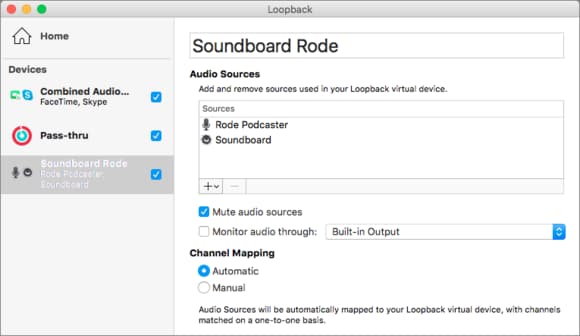
- WINDOWS AUDIO LOOPBACK DRIVER
- WINDOWS AUDIO LOOPBACK TRIAL
- WINDOWS AUDIO LOOPBACK FREE
- WINDOWS AUDIO LOOPBACK WINDOWS
After every reboot, it will work again for an additional 60 minutes.
WINDOWS AUDIO LOOPBACK TRIAL
The trial version of LoopBeAudio works for 60 minutes after its first use.
WINDOWS AUDIO LOOPBACK FREE
Free Evaluation Copyĭownload our free evaluation copy here. It keeps LoopBeAudio's playback and record format in sync, displays details like format, monitor and default device and gives you fast access to the Sound Control Panel.
WINDOWS AUDIO LOOPBACK DRIVER
LoopBeAudio's driver comes with a small system tray application. While using LoopBeAudio you can forward the audio data to your "real" audio output, without the need for matching formats A little Status Application in your System Tray.
WINDOWS AUDIO LOOPBACK WINDOWS
LoopBeAudio lets you configure an audio device with more than 8 channels, but Windows will not provide the speaker positions here, therefore LoopBeAudio will behave like a multichannel Line device Independent Monitoring LoopBeAudio's "Internal Playback" simulates virtual speakers with all possible surround configurations of Windows.Ĭonfigure up to 24 channels with Virtual Line devices

Test every Surround Setup with Virtual SpeakersĬonfigure LoopBeAudio with the Windows Sound Control Panel like every other audio device. Programs do not need to link with special libraries, so LoopBeAudio works with every audio-capable Windows application. LoopBeAudio is a native Windows™ WDM kernel mode driver, so expect the lowest possible latency. Build a virtual 7.1 surround device, even though you don't have the built-in hardware.

Configure up to 24 audio channels, a sample rate from 8000 Hz to 384000 Hz with a bit depth from 8 bit to 32 bit. The technical limits are only restricted through the Operating System. LoopBeAudio is a virtual audio device to transfer audio between computer programs, digitally, without any quality loss. To actually hear the sound, you could get a splitter, and then output the audio to headphones or speakers at the same time you direct it back into your computer.LoopBeAudio A Virtual Audio Cable - An Audio Loopback Driver Thanks to its Multi-Format Audio Engine, VB-CABLE can be used without any configuration Ready to work with all Audio Application using MME, KS, DX, KS or WASAPI interfaces. You’ll stop hearing the sound your computer produces, but you can use any audio-recording program to record the “line in” or “microphone” input. VB-Audio CABLE is a Windows Audio Driver working as Virtual Audio Cable. Plug one end into the line-out (or headphone) jack on your PC, and the other end into the line-in (or microphone) jack. Just get an audio cable with a male 3.5mm connector on both ends. It makes tinkering with the audio of each individual application much easier. If neither of the first two options suit your needs, there’s always the low-tech solution-although it’s a bit of a hack. Ever wanted to record your speaker output (loopback) This is for you. In other words, your recorded sound file will be higher-quality when using Audacity’s WASAPI loopback option. System sounds playing through the device selected for WASAPI loopback are still captured, however.” “WASAPI loopback has an advantage over stereo mix or similar inputs provided by the soundcard that the capture is entirely digital (rather than converting to analog for playback, then back to digital when Audacity receives it). For example, If you have a 7.1 channel headset, select “8.”Īudacity’s tutorial website explains why this feature is actually better than Stereo Mix: Update: If this doesn’t work, you may also need to select the correct number of recording channels to match your device using the dropdown box to the right of device selection box. Because you’re using Audacity, you can easily trim and edit the sound file when you’re done. RELATED: The How-To Geek Guide to Audio Editing: The BasicsĬlick the Record button to start recording the audio in Audacity, and then click Stop when you’re done. In Audacity, choose the “Windows WASAPI” audio host, and then choose an appropriate loopback device, such as “Speakers (loopback)” or “Headphones (loopback).” The feature also functions in Windows 7, 8, and 10, and helps make up for the lack of a Stereo Mix option on modern Windows PCs. This method takes advantage of a feature that Microsoft added in Windows Vista named the Windows Audio Session API (WASAPI). In fact, Audacity’s feature may be even better than Stereo Mix, assuming you’re willing to use Audacity to record the audio.

Audacity has a useful feature that can record the audio coming out of your computer-even without Stereo Mix. Option 2: Audacity’s WASAPI Loopbackĭon’t have a Stereo Mix option? No problem.

It’s unfortunately become less and less common. There may be a way to enable it with different audio drivers, but not every piece of sound hardware supports Stereo Mix. On some devices, you may not have this option at all.


 0 kommentar(er)
0 kommentar(er)
